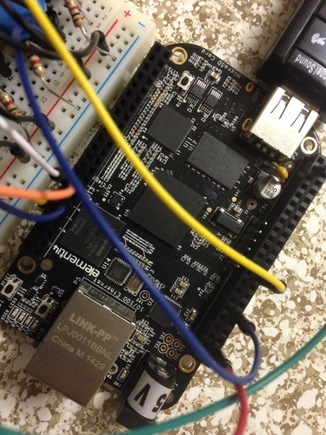Every year, interns spending their summers at Texas Instruments are challenged to test their creativity, technical prowess and might in a competitive design challenge based on TI technology. This year, we are challenging our interns to create a solution based on a TI MCU LaunchPad™ or the Sitara™ processor-based BeagleBone Black. The blog below was guest written by TI interns and Top BeagleBone Black Design winners Sumita Ghosh, Ashish Joshi and Jeffrey Mueller.
When I was in fifth grade, my teacher made us submit projects relevant to the topics we were covering each month. Typically, no one made anything more complicated than a poster, but I had this idea of a music box that you could use as an instrument when you pressed buttons. A decade later, Texas Instruments (TI) gave me the opportunity to make such a device and simultaneously learn how to work with a platform no one in my team had ever used before: the BeagleBone Black.
We call it the Keychain Synth because it’s a music-making device that is small enough to carry around on a keychain. The idea behind the project was that sometimes you’re somewhere inconvenient for composing purposes, but you have an idea for a song in your head, and you want to let it out before the idea slips away. Because it had to be compact, the circuit board we used has no components on the top – all of the electronics are soldered to the backside of the cape, so that the only things visible are the capacitive touch buttons and nothing adds bulk to the device. The buttons themselves are simple sensors that connect a single copper pad to a touch sensor (either the AT42QT1010 or the AT42QT1012) buffered with a few passive components, each connected to a single GPIO pin. The nice thing about that type of button is that the copper pad could be electrically connected to another conductive material such as aluminum foil, and then that material would become the new button. BeagleBone Black has a lot of GPIO pins so adding buttons for more instruments is easy. It’s also pretty powerful so running an external keyboard, a soundcard, and composition software off of it at the same time doesn’t overwork the processor.
Designing the synth was initially challenging because none of my teammates knew how to program BeagleBone Black to make it play sounds on command, which is what every instrument should do. We spent a lot of time trying to figure out Pure Data (the composition software we were running on BeagleBone Black), and after a long while, Ashish figured out how to alter the program to allow it to play other sounds and add inputs. One of our buttons is even programmed to cycle through different noises!
However, just because the competition is over doesn’t mean that the project is complete. Now that the prototype works, we’re going to add LEDs to it and as well as a connector in the board to make it easier to connect other conductors to the Keychain Synth. We’ll also add a coin cell battery to the cape so the synth doesn’t have to be plugged in to work. I’m really excited to keep working on it, and my whole team is grateful to TI for allowing us this opportunity to create something awesome.
To follow and learn more about this project, or to make one of your own, visit this link.


